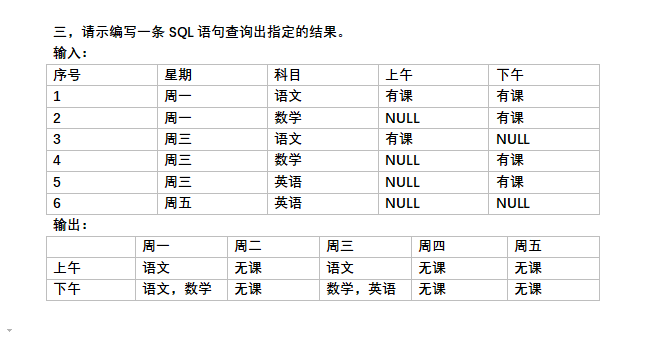How to enable or disable an anchor using jQuery?
问题:
回答1:
To prevent an anchor from following the specified href, I would suggest using preventDefault():
// jQuery 1.7+
$(function () {
$(\'a.something\').on(\"click\", function (e) {
e.preventDefault();
});
});
// jQuery < 1.7
$(function () {
$(\'a.something\').click(function (e) {
e.preventDefault();
});
// or
$(\'a.something\').bind(\"click\", function (e) {
e.preventDefault();
});
});
See:
http://docs.jquery.com/Events/jQuery.Event#event.preventDefault.28.29
Also see this previous question on SO:
jQuery disable a link
回答2:
The app I\'m currently working on does it with a CSS style in combination with javascript.
a.disabled { color:gray; }
Then whenever I want to disable a link I call
$(\'thelink\').addClass(\'disabled\');
Then, in the click handler for \'thelink\' a tag I always run a check first thing
if ($(\'thelink\').hasClass(\'disabled\')) return;
回答3:
I found an answer that I like much better here
Looks like this:
$(document).ready(function(){
$(\"a\").click(function () {
$(this).fadeTo(\"fast\", .5).removeAttr(\"href\");
});
});
Enabling would involve setting the href attribute
$(document).ready(function(){
$(\"a\").click(function () {
$(this).fadeIn(\"fast\").attr(\"href\", \"http://whatever.com/wherever.html\");
});
});
This gives you the appearance that the anchor element becomes normal text, and vice versa.
回答4:
$(\"a\").click(function(){
alert(\'disabled\');
return false;
});
回答5:
I think a nicer solution is to set disabled data attribute on and anchor an check for it on click. This way we can disable temporarily an anchor until e.g. the javascript is finished with ajax call or some calculations. If we do not disable it, then we can quickly click it a few times, which is undesirable...
$(\'a\').live(\'click\', function () {
var anchor = $(this);
if (anchor.data(\"disabled\")) {
return false;
}
anchor.data(\"disabled\", \"disabled\");
$.ajax({
url: url,
data: data,
cache: false,
success: function (json) {
// when it\'s done, we enable the anchor again
anchor.removeData(\"disabled\");
},
error: function () {
// there was an error, enable the anchor
anchor.removeData(\"disabled\");
}
});
return false;
});
I made a jsfiddle example: http://jsfiddle.net/wgZ59/76/
回答6:
It\'s as simple as return false;
ex.
jQuery(\"li a:eq(0)\").click(function(){
return false;
})
or
jQuery(\"#menu a\").click(function(){
return false;
})
回答7:
Selected Answer is not good.
Use pointer-events CSS style. (As Rashad Annara suggested)
See MDN https://developer.mozilla.org/en-US/docs/Web/CSS/pointer-events. Its supported in most browsers.
Simple adding \"disabled\" attribute to anchor will do the job if you have global CSS rule like following:
a[disabled], a[disabled]:hover {
pointer-events: none;
color: #e1e1e1;
}
回答8:
Try the below lines
$(\"#yourbuttonid\").attr(\"disabled\", \"disabled\");
$(\"#yourbuttonid\").removeAttr(\"href\");
Coz, Even if you disable <a> tag href will work so you must remove href also.
When you want enable try below lines
$(\"#yourbuttonid\").removeAttr(\"disabled\");
$(\"#yourbuttonid\").attr(\"href\", \"#nav-panel\");
回答9:
$(\'#divID\').addClass(\'disabledAnchor\');
In css file
.disabledAnchor a{
pointer-events: none !important;
cursor: default;
color:white;
}
回答10:
$(\"a\").click(function(event) {
event.preventDefault();
});
If this method is called, the default action of the event will not be triggered.
回答11:
If you are trying to block all interaction with the page you might want to look at the jQuery BlockUI Plugin
回答12:
You never really specified how you wanted them disabled, or what would cause the disabling.
First, you want to figure out how to set the value to disabled, for that you would use JQuery\'s Attribute Functions, and have that function happen on an event, like a click, or the loading of the document.
回答13:
For situations where you must put text or html content within an anchor tag, but you simply don\'t want any action to be taken at all when that element is clicked (like when you want a paginator link to be in the disabled state because it\'s the current page), simply cut out the href. ;)
<a>3 (current page, I\'m totally disabled!)</a>
The answer by @michael-meadows tipped me off to this, but his was still addressing scenarios where you still have to / are working with jQuery/JS. In this case, if you have control over writing the html itself, simply x-ing the href tag is all you need to do, so the solution is a pure HTML one!
Other solutions without jQuery finagling which keep the href require you to put a # in the href, but that causes the page to bounce to the top, and you just want it to be plain old disabled. Or leaving it empty, but depending on browser, that still does stuff like jump to the top, and, it is invalid HTML according to the IDEs. But apparently an a tag is totally valid HTML without an HREF.
Lastly, you might say: Okay, why not just dump the a tag altogether than? Because often you can\'t, the a tag is used for styling purposes in the CSS framework or control you\'re using, like Bootstrap\'s paginator:
http://twitter.github.io/bootstrap/components.html#pagination
回答14:
So with a combination of the responses above, I came up with this.
a.disabled { color: #555555; cursor: default; text-decoration: none; }
$(\".yourClass\").addClass(\"disabled\").click(function(e){ e.preventDefault();
回答15:
If you don\'t need it to behave as an anchor tag then I would prefer to replace it at all. For example if your anchor tag is like
<a class=\"MyLink\" href=\"http://www.google.com\"><span>My</span> <strong>Link</strong></a>
then using jquery you can do this when you need to display text instead of a link.
var content = $(\".MyLink\").text(); // or .html()
$(\".MyLink\").replaceWith(\"<div>\" + content + \"</div>\")
So this way, we can simply replace anchor tag with a div tag. This is much easier (just 2 lines) and semantically correct as well (because we don\'t need a link now therefore should not have a link)
回答16:
Disable or Enable any element with the disabled property.
// Disable
$(\"#myAnchor\").prop( \"disabled\", true );
// Enable
$( \"#myAnchor\" ).prop( \"disabled\", false );


